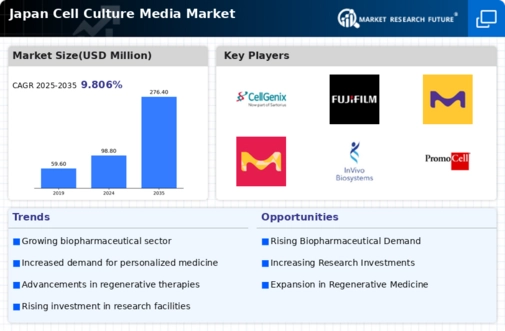Growing Demand for Stem Cell Research
The cell culture-media market in Japan is witnessing a notable increase in demand driven by the burgeoning field of stem cell research. As researchers and institutions focus on regenerative medicine, the need for specialized culture media tailored for stem cell applications is becoming more pronounced. In 2025, the market for stem cell research-related products is expected to grow by around 12%, indicating a strong interest in this area. This growth is likely to stimulate advancements in cell culture media formulations, as companies strive to meet the specific requirements of stem cell applications. Additionally, collaborations between academic institutions and industry players are expected to enhance the development of innovative media solutions. The emphasis on stem cell research is poised to significantly impact the cell culture-media market, creating new avenues for growth and development.
Increasing Investment in Biotechnology
The cell culture-media market in Japan is experiencing a surge in investment, particularly from both public and private sectors. This influx of capital is primarily directed towards research and development initiatives aimed at enhancing biopharmaceutical production. In 2025, the biotechnology sector in Japan is projected to grow at a CAGR of approximately 8%, indicating a robust interest in innovative solutions. This financial commitment is likely to bolster the cell culture-media market, as companies seek to develop more efficient and effective media formulations. Furthermore, the Japanese government has been actively promoting biotechnology through various funding programs, which may further stimulate growth in the cell culture-media market. As a result, the landscape for biopharmaceuticals and regenerative medicine is expected to evolve, creating new opportunities for stakeholders in the cell culture-media market.
Expansion of Academic and Research Institutions
The proliferation of academic and research institutions in Japan is contributing to the growth of the cell culture-media market. With an increasing number of universities and research centers focusing on life sciences, the demand for high-quality cell culture media is likely to rise. In 2025, it is estimated that the number of research publications related to cell culture techniques will increase by approximately 20%, reflecting heightened academic interest. This trend may lead to greater collaboration between academia and industry, fostering innovation in media development. Furthermore, as educational programs expand, a new generation of researchers is entering the field, potentially driving demand for advanced cell culture media. The expansion of academic and research institutions is expected to play a pivotal role in shaping the future of the cell culture-media market.
Regulatory Support for Cell Culture Innovations
Japan's regulatory environment appears to be increasingly supportive of innovations in the cell culture-media market. The Pharmaceuticals and Medical Devices Agency (PMDA) has streamlined approval processes for new biopharmaceuticals, which may encourage companies to invest in advanced cell culture technologies. This regulatory facilitation is crucial, as it can significantly reduce the time and cost associated with bringing new products to market. In 2025, it is anticipated that the approval rate for new biopharmaceuticals will increase by approximately 15%, reflecting a more favorable climate for innovation. Consequently, this supportive regulatory framework could lead to a proliferation of novel cell culture media products, enhancing the overall market landscape. The alignment of regulatory policies with industry needs is likely to foster a more dynamic and competitive environment within the cell culture-media market.
Rising Focus on Quality Control and Standardization
Quality control and standardization are becoming increasingly critical in the cell culture-media market in Japan. As the demand for biopharmaceuticals grows, the need for consistent and reliable media formulations is paramount. In 2025, it is projected that approximately 30% of companies will prioritize quality assurance measures in their production processes. This focus on quality is likely to lead to the development of standardized protocols and testing methods, ensuring that cell culture media meet stringent regulatory requirements. Additionally, the emphasis on reproducibility in research may drive companies to invest in quality control technologies. As a result, the cell culture-media market may witness a shift towards more rigorous quality standards, enhancing the overall reliability of products available in the market.





















Leave a Comment